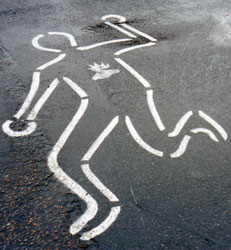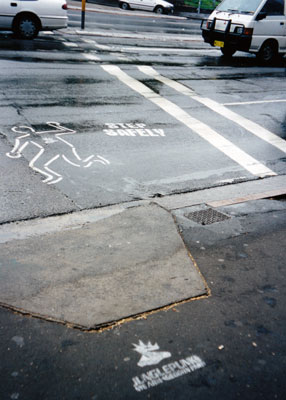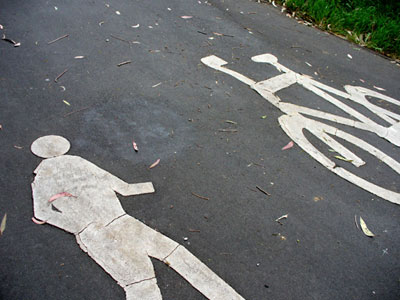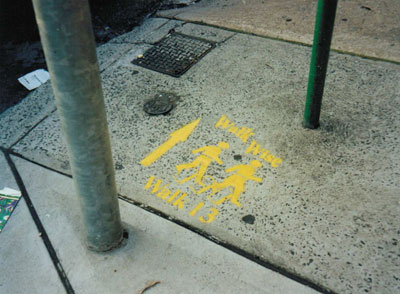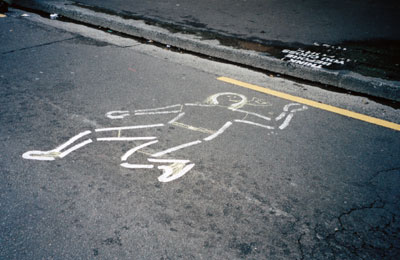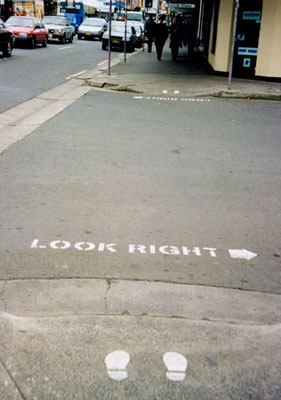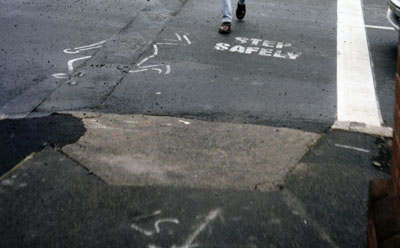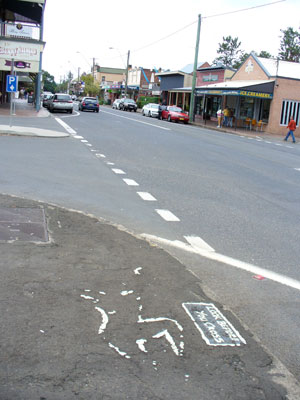My WordPress avatar is a pedestrian traversing the asphalt. Despite a continuous battering by passing traffic, you can see that my pedestrian still has a burning heart, thanks to an implant by the 90s band Junglepunks.
I have met many such pavement people since I began my graffiti project way back in 1999, but I seem to have only mentioned them once on this blog site. A desire to revisit them has been prompted by some of the photographs in a new little book by Phil Smith, Enchanted things, where he writes:
‘The pedestrian figures here were all intended by some designer as generic representations; yet to the glad eye they display their eccentricities, amputations, stretch marks, wrinkles, prostheses and rearrangements. They serves as memento mutabis (“remember you will change”), a reminder of your body as unfinished business, inscribed into its path and subject to all that passes along it, a history made on the hoof.’
In this photo-essay Phil, an ambulant academic at Plymouth University, UK, urges us to undertake an ‘experimental pilgrimage without destinations’ where disfigured pedestrian figures are just a small sample of the absurd, ironic and accidental artworks in the urban landscape that, if we take the trouble to notice them, will rearrange our attitude to the world.
My Sydney pavement pedestrians serve to confirm that walking in the builtscape is no simple matter. They don’t need Phil to tell them they should LOOK, LOOK RIGHT, LOOK LEFT. But even if they have an opinion about what they see, they are made to shut up. It is sometimes permissible for them to manifest their gender or age status, but more often than not they are stripped to their naked genderlessness, a mere shadow of their supposed selves.
Although exposed to assault from all sides, they can hardly complain they weren’t warned. Even so, when cautioned to THINK BEFORE YOU CROSS and STEP SAFELY they generally decide to make a dash for it. Some do so with a defiant display of insouciance but others are so terrified by the traffic they jump right out of their shoes.
The more purposeful striders who stick to the footpath find they are obliged to share their way with cyclists and sometimes even elephants. Hidden trenches and falling manhole covers are additional hazards.
Casualties are high and many pavements are haunted by the remains of hapless pedestrians, last seen in healthy condition maybe twenty years ago, now reduced to making ghostly appearances from between the cracks in the asphalt.
Like my flat mates, I find it hard to keep up with Phil’s ambulant ruminations. Nevertheless, the next item on my reading list is another recent book by him, larger in size and no doubt equally challenging. Â It’s called On walking … and stalking Sebald and its cover features an array of pedestrian figures. How could I resist?
Smith, Phil, 2014, Enchanted things: signposts to a new nomadism, Axminster: Triarchy Press.
Smith, Phil, 2014, On walking … and stalking Sebald: a guide to going beyond wandering around looking at stuff, Axminster: Triarchy Press.
